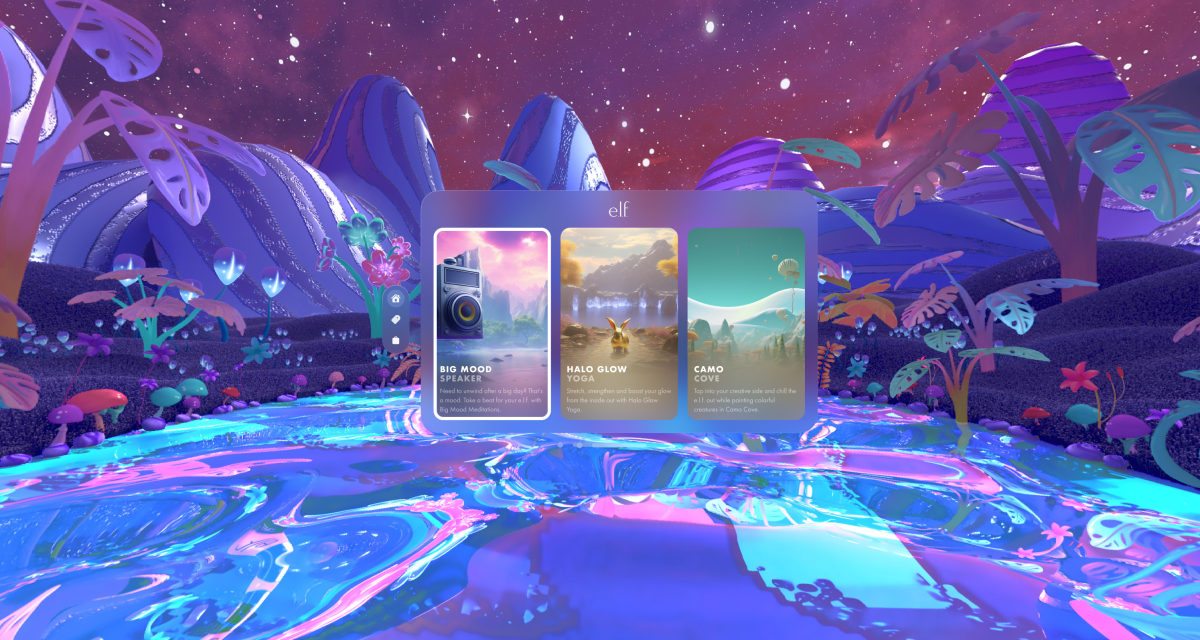Brands are betting on Apple Vision Pro’s potential as a shopping channel

When Apple made its virtual reality goggles available to the U.S. last week, brands rushed to be among the first in their categories to launch a shopping app on the device.
E.l.f. Cosmetics introduced a visionOS app, called Your Best E.l.f., where users can play games as well as shop an assortment of 3D beauty products. Alo Yoga launched Alo Sanctuary, an immersive shopping and meditation app that lets people meditate in outdoor environments and shop the brand’s products in 3D. Lowe’s, on the other hand, released a home improvement experience on the device dubbed Lowe’s Style Studio. The apps themselves are free, though people can buy products within the app using Apple Pay.
Apple Vision Pro combines internet images with the wearer’s physical environment. The device retails for $3,499 and has 600 apps available that are specifically developed to offer a “spatial computing experience” — an umbrella term that covers concepts like augmented reality, virtual reality and mixed reality. The launch of Apple Vision Pro could usher in a new era of online shopping and customer engagement. And the brands that are launching the first Vision Pro apps want to make sure they get in on the ground floor.
“Spatial computing is going to change the way we shop and become part of a consumer’s lifestyle,” Ekta Chopra, chief digital officer, E.l.f. Beauty, told Modern Retail in an email. “We [are] looking to test and learn and explore this new unchartered territory.”
Unlike traditional online shopping, Apple Vision Pro allows users to visualize products in 3D. Shopping with spatial computing allows users to better understand how items would look from different angles and how it would look alongside other items. Lowe’s app, for instance, lets people design their dream kitchens by letting them choose different fixtures, appliances and other materials. The Lowe’s Style Studio app currently offers 80 billion different combinations.
Lowe’s told Modern Retail in an email that the traditional way of shopping through smartphones and computers doesn’t accurately reflect people’s homes. “Launching Lowe’s Style Studio on Apple Vision Pro is not just about keeping pace with technological advancements,” Cheryl Friedman, vice president of Lowe’s Innovation Labs, wrote. “It’s about meeting our customers’ evolving expectations, and delivering innovative solutions that simplify and enhance the home improvement experience.”
By incorporating additional features like games and interactive elements, customers could potentially spend more time on the app. For example, Alo Yoga’s app offers 20 complimentary meditation exercises across different environments: the beach, mountains, canyons and jungle. Meanwhile, E.l.f.’s app features branded games.
Ad position: web_incontent_pos1
Additionally, the technology allows brands to sell or engage with people who might not live close to a physical store, said Neha Singh, CEO of VisionOS developer Obsess, the company who worked alongside E.l.f, Alo Yoga and J.Crew to develop their Apple Vision Pro apps. For instance, the J.Crew Virtual Closet app uses a tool called SharePlay, where users can interact with the brand’s stylists or host group calls to get other people’s opinions on an outfit.
“It’s the next best thing to actually seeing it in-person in a store,” Singh said. “It’s like the most advanced way of digital clienteling that has existed.”
For now, the brands that Obsess works with only feature a limited selection of their inventory on the app, but Singh said brands intend to update their assortment seasonally. In recent years, Obsess has worked with brands to create virtual stores, which can be found on their brand partners’ websites. Singh said that people spend more than twice the amount of time on one page in these virtual stores than all the other pages of an e-commerce website combined.
“Our data shows that the engagement is higher in these experiences in terms of session time [and] interactions,” Singh said. “Sometimes the conversion rate is higher, sometimes the average order value is higher through these experiences.”
Singh said that this channel also helps brands acquire valuable data. J.Crew, for example, can get data on which outfits users are trying on their virtual avatar, which outfit combinations are popular and which outfits are saved.
Ad position: web_incontent_pos2
Although there is an opportunity for brands to be an early adopter of this shopping channel, it can be risky, said Aron Bohlig, managing partner at boutique investment bank ComCap. Because this technology is still fairly young, the early iterations of these apps could still be buggy or have issues in the software developmental packages available.
“Sometimes the first version of an app like this can be challenging for a consumer and obviously that would leave a bad taste,” Bohlig said. He added that some categories are better suited for this technology than others, such as cosmetics and home goods. “In some categories, it may be iffy whether it’s really going to be ROI positive.”
Moreover, it can be hard to tell how widespread the adoption of this technology will be. So far, Apple has sold around 180,000 Vision Pros during the pre order period. For now, brands who are launching shopping apps on Apple Vision Pro are optimistic.
“In terms of where we go next… we have no shortage of ideas and look forward to sharing them in the future,” Lowe’s Friedman said. “Right now, we’re eager to see how Apple Vision Pro customers use it – and what they create with the app.”

